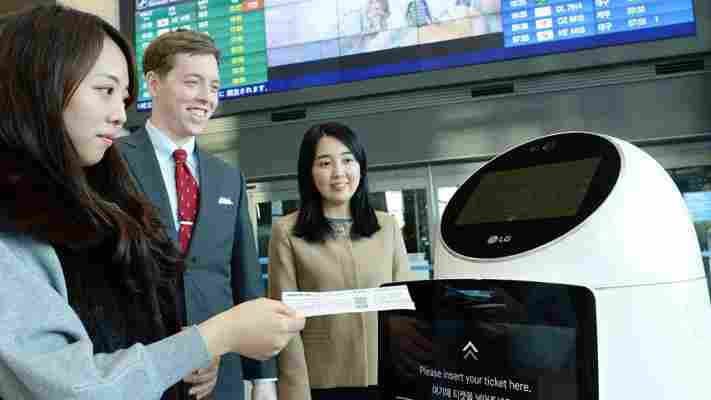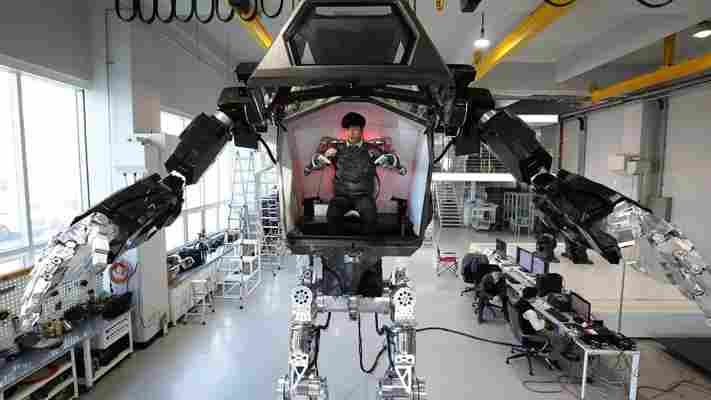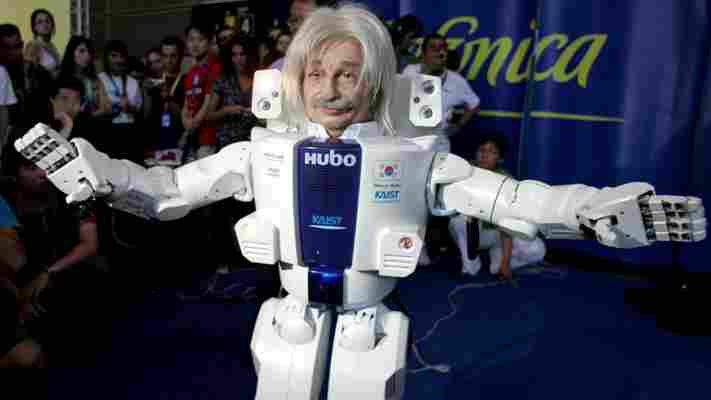Article continues below
At Incheon International Airport (ICN), outside South Korea’s capital Seoul, a team of congenial staff will help you find your boarding gate or escort you to the nearest lounge. They’re well trained, well behaved and quadrilingual to boot – but they’re not so good at small talk. That’s because they’re robots.
The robotic airport guides, developed by Korean tech titan LG Electronics, have been working alongside human employees since the end of July 2017. Standing 1.4m tall, they move autonomously on a wheelbase, display an LCD information screen and navigate using cameras and ultrasonic, laser and edge sensors. They can also recognise voice and process language.

South Korea’s Incheon Airport recently installed robotic airport guides to assist passengers (Credit: LG Electronics)
You may also be interested in: • Why Milan is covering its skyscrapers in plants • Chicago’s underground city that’s becoming a design star • Harris Tweed: from island cloth to cutting-edge fabric
They’re not the only robots to be making headlines in South Korea, as the country prepares to host the upcoming 2018 Winter Olympics from 9-25 February in the north-eastern city of Pyeongchang.
Others include Hankook Mirae Technology’s towering Method-2 , proclaimed to be the world’s first manned bipedal robot, and DRC-HUBO , a humanoid robot with transformer capabilities, created by the Korean Advanced Institute of Science and Technology and 2015 winner of the Defense Advanced Research Project Agency (DARPA) Robotics Challenge. LG has also developed another airport robot, a cleaner that uses mapping and obstacle-avoidance technology to calculate the most efficient pathways and keep the space sparkling.
Robots and related solutions are not just new gadgets, but key technologies to support humans
South Korea, along with its easterly neighbour Japan, has for many years been known for its cutting-edge intelligent designs, having already deployed robotic teachers, industrial manufacturing workers and service staff. Together, they make up a futuristic workforce where autonomous devices are stepping in to fill human roles.
“In our view, artificial intelligence, robots and related solutions are not just new gadgets, but key technologies to support humans,” said Jae-myoung Hong, senior engineer in LG’s Smart Solutions Division. “In some cases, robots may perform jobs that are too dangerous or too complicated for regular workers.”

Method-2 is considered to be the world’s first human-operated bipedal robot (Credit: Chung Sung-Jun/Getty Images)
While South Korea is hurtling toward a brave new world, it’s rooted in a familiar old one, too. It is that ancient heritage, replete with animals who have their own hopes and dreams, trees with souls and mountains with spirits, that may have, in some way, helped influence South Korea’s modern technology.
The innovation powerhouse might not even exist today – at least if Korean folklore has anything to say about it – if it weren’t for one bear who was as persistent as she was optimistic.
The innovation powerhouse might not exist today if it weren’t for one bear
This bear, more than 4,300 years ago, was high atop a mountain with a tiger. They both longed to be human. Taking pity on them, the son of the Lord of Heaven gave them two sacred foods, garlic cloves and mugwort, and told them to ration the supply and stay out of the sun for 100 days. Impatient, the tiger quickly quit. The bear, though, made it to the end of the challenge, transforming into a woman who went on to marry the son of the Lord of Heaven and give birth to a son of her own. Named Dangun , he took the throne and became the ruler of the land.
And so, the Korean kingdom owed its creation to an animal who achieved very human aspirations.

South Korea’s ancient animist legends may have helped influence the nation's appreciation of modern technology (Credit: Jose Jordan/Getty Images)
The nation’s foundation myth, celebrated every 3 October, is just one in a collection of animist legends that form a cornerstone of the country’s oldest religion: shamanism. Even today, shamanist attitudes remain “embedded” in the Korean psyche, influencing “business, politics and everyday lives,” according to Kwang-yeong Shin, professor of sociology at Chung-ang University in Seoul.
Any kind of non-human being might have a spiritual or super power beyond human capacity
In the Korean shamanist faith, many of whose core elements have been incorporated into Buddhism, it’s not unusual to think that a passing bird could carry the reincarnated soul of your dead uncle, or even that a meaningful memento or particularly beloved musical instrument might have sacred spirits of their own. “We can think that any kind of non-human being might have a spiritual or super power beyond human capacity, whether it is a natural object or artificial object,” Shin told me.
All of which makes the idea of other non-humans – such as robots – adopting human qualities not exactly cause for alarm in South Korea.
“It makes sense that animistic features of shamanism might go well with robots, which are not living agents but have some characteristics of human beings,” said Dong-kyu Kim, a shamanism scholar at Sogang University’s Institute for the Study of Religion.
South Korea sold more than 41,000 robots in 2016 (Credit: Jung Yeon-Je/Getty Images)
In this way, ancient spirituality may have primed the Korean people to be more culturally and socially open-minded to autonomous devices than perhaps Westerners. Armed with this accepting attitude, South Korea became an ideal breeding ground, and consumer market, for advanced robotics innovation.
In 2016, South Korea sold more than 41,000 robots, second most on the planet, according to the International Federation of Robotics (IFR) . That’s nearly half as many as China, which is more than 25 times as populous and 95 times as big. In fact, South Korea has the highest level of industrial robot density in the world. In the manufacturing industry, there are 631 robot workers for every 10,000 human employees, reports IFR. And in the automotive industry, 2,145 for every 10,000.
There are 631 robot workers for every 10,000 human employees
Some Koreans do feel concerned this will result in fewer jobs for themselves, but in the minds of many, the concern stops there. “Mass media anticipated many Korean people… would lose their jobs. However, that was it,” Kim said. “Since then, it is rare to hear about worry regarding robots.”
Meanwhile in the US, consider the doomsday scenarios depicted in mainstream cinema, from The Terminator to The Matrix to I, Robot, and by the apocalyptic discourse of some of the nation’s tech leaders, like Elon Musk. ( According to a recent Pew Research survey , 72% of Americans are in fact very or somewhat worried about the future of automation.)
After the Korean War, the country’s government put its manufacturing sector front and centre (Credit: JUNG YEON-JE/Getty Images)
So, while some people may feel anxious that robots will not only steal all their jobs, but also develop a superior and unstoppable intelligence, stage a coup and, in a Frankenstein-like fate, destroy the very people who created them, Koreans just aren’t that panicked.
Of course, it’s much more complex than that. Koreans have always recognised a certain necessity, too.
After the Korean War, which ended in 1953, the country’s government set out to pull itself out of poverty by putting its manufacturing sector front and centre. That precipitated the need to develop high-tech innovation and a highly skilled workforce – both of which helped make South Korea the economic success story it is today. Indeed South Korea has ranked as the world’s most innovative economy for the past four years in a row, according to the Bloomberg Innovation Index , and the country spent more than any other on research and development in 2014, when measured by share of GDP, reports the Organization for Economic Cooperation and Development .
Tech-savvy, community-minded and intensely pragmatic, Koreans might be more eager than many markets, then, to view artificial intelligence as part of the solution, not the problem. Instead of worrying about an AI apocalypse, they’re figuring out how robots can make their lives better, helping to solve a vast range of social troubles from the very small to the large and looming.
In 2014, South Korea spent more than any country on research and development (Credit: Bloomberg/Getty Images)
LG, for example, is working to develop more and more types of robots that can optimise both the home – from autonomous lawnmowers to smart appliances – and beyond, including hotels, shopping malls, tourist centres and other public spaces. “Our goal is to identify areas where automated devices can add the most value,” said Hong, who expects some of the company’s robots to be ready for commercial release within the next one to two years.
Future applications of robotics innovation could also make it possible for South Korea to not only replace a workforce that’s rapidly aging and retiring, but also care for it. And, perhaps even more urgently, artificial intelligence could play an increasingly important role in defending the country’s DMZ border with North Korea, which has already seen the deployment of semi-autonomous sentries like the SGR-A1 , first developed by Samsung.
Back in Incheon, where the robot guides are about to finish their pilot programme, the airport is preparing to welcome some of them as full-time workers in early 2018. So if you happen to find yourself at ICN, keep an eye out for a merry, if mechanical, guide, who will be more than happy to show you around.
Join more than three million BBC Travel fans by liking us on Facebook , or follow us on Twitter and Instagram .
If you liked this story, sign up for the weekly bbc.com features newsletter called "If You Only Read 6 Things This Week". A handpicked selection of stories from BBC Future, Earth, Culture, Capital and Travel, delivered to your inbox every Friday.
Leave a Comment